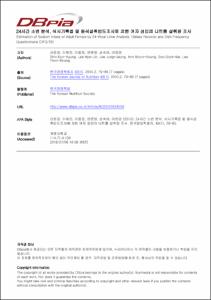KUMEL Repository
1. Journal Papers (연구논문)
1. School of Medicine (의과대학)
Dept. of Preventive Medicine (예방의학)
24시간 소변 분석, 식사기록법 및 음식섭취빈도조사에 의한 여자 성인의 나트륨 섭취량 조사
- Keimyung Author(s)
- Lee, Jung Jeung
- Department
- Dept. of Preventive Medicine (예방의학)
- Journal Title
- 한국영양학회지
- Issued Date
- 2010
- Volume
- 43
- Issue
- 1
- Abstract
- ABSTRACTThis study assesses the sodium intake of adults by 24-hour urine analysis, dietary records review and a food intake
questionnaire. Subjects were 236 adult female in Daegu. The results are summarized as follows: Sodium intake as
indicated by the 24-hour urine analysis was 5,805.4 ± 3836.8 mg. This was significantly higher than intake indicated
by dietary records (4415.4 ± 1935.1 mg) and the dish frequency questionnaire (DFQ 55)(4293.5 ± 1526.5 mg). The
results of the 24-hour urine analysis and DFQ 55 showed that sodium intake was higher for the 65-to-74-year-old age
group than for other age groups (p < 0.05, p < 0.05). Review of dietary records to examine typical sodium intake by
food groups showed that 53.7% of the sodium consumed by subjects in all age groups came from seasonings and
spices (2399.0 ± 1526.5 mg). The analysis of sodium intake by food groups using DFQ 55 showed 34.2% of their
sodium came from consumption of kimchi (p < 0.001) and kimch, soup, stew and fish jorim accounted for 57.8% of
total sodium intake. The results indicate positive correlation between age and sodium intake, as shown by the 24-hour
urine analysis and food intake questionnaire (p < 0.05). Therefore, these results would be valuable as basic data for
planning nutrition education for sodium intake reduction. (Korean J Nutr 2010; 43(1): 79 ~ 85)
KEY WORDS: sodium intake, 24-hour urine analysis, dietary record, dish frequency questionnaire.
- Alternative Title
- Estimation of Sodium Intake of Adult Female by 24-Hour Urine Analysis,
Dietary Records and Dish Frequency Questionnaire (DFQ 55)*
- Keimyung Author(s)(Kor)
- 이중정
- Publisher
- School of Medicine
- Citation
- 신은경 et al. (2010). 24시간 소변 분석, 식사기록법 및 음식섭취빈도조사에 의한 여자 성인의 나트륨 섭취량 조사. 한국영양학회지, 43(1), 79–85. doi: 10.4163/kjn.2010.43.1.79
- Type
- Article
- ISSN
- 0367-6463
- Appears in Collections:
- 1. School of Medicine (의과대학) > Dept. of Preventive Medicine (예방의학)
- 파일 목록
-
-
Download
 oak-bbb-05234.pdf
기타 데이터 / 745.23 kB / Adobe PDF
oak-bbb-05234.pdf
기타 데이터 / 745.23 kB / Adobe PDF
-
Items in Repository are protected by copyright, with all rights reserved, unless otherwise indicated.